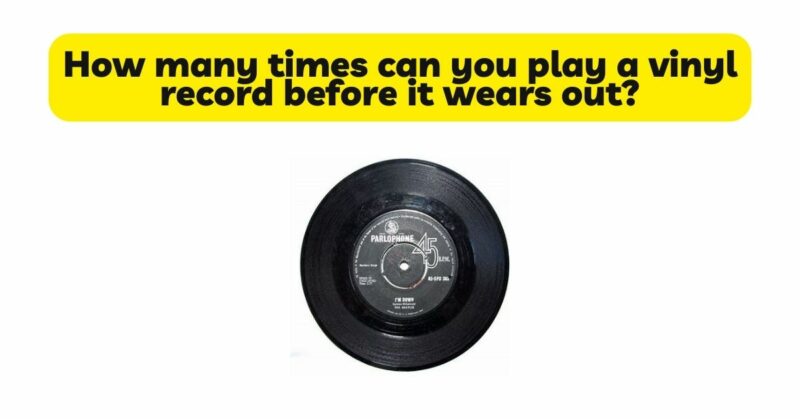Vinyl records have stood the test of time as a beloved medium for music enthusiasts, offering a nostalgic and authentic listening experience. However, a common question among vinyl enthusiasts is how many times a record can be played before it wears out. In this article, we will explore the factors that contribute to the lifespan of a vinyl record, including vinyl durability, stylus wear, and proper care. By understanding these elements, we can gain insights into how to extend the longevity of our cherished vinyl collections.
- Vinyl Durability and Longevity
Vinyl records are known for their durability, which contributes to their longevity. Here are some key factors that determine the lifespan of a vinyl record:
a) Vinyl Composition: Vinyl records are typically made of polyvinyl chloride (PVC), a resilient material. PVC offers a good balance between flexibility and strength, allowing records to withstand repeated plays without significant wear.
b) Pressing Quality: The quality of the record pressing plays a crucial role in its durability. Well-pressed records with proper thickness and consistent grooves are more likely to withstand frequent plays without wearing out quickly.
c) Groove Depth: Vinyl records have deep grooves that are designed to accommodate the stylus. The depth of the grooves provides a certain level of protection against wear, as the stylus tracks within the grooves without excessively scraping the vinyl surface.
d) Handling and Care: Proper handling and care of vinyl records are essential for preserving their longevity. Regular cleaning, proper storage, and gentle handling help minimize wear and extend the lifespan of the record.
- Stylus Wear and its Impact on Vinyl
While vinyl records are relatively durable, the stylus (needle) used for playback can contribute to wear over time. Here’s how stylus wear affects the lifespan of a vinyl record:
a) Stylus Material: The material composition of the stylus tip plays a significant role in its longevity and its impact on the vinyl record. High-quality styli made of diamond or diamond-tipped styli are known for their durability and minimal wear on records.
b) Stylus Condition: The condition of the stylus is crucial in preventing excessive wear on vinyl records. A worn or damaged stylus can dig into the grooves, causing accelerated wear and potentially damaging the record’s surface.
c) Tracking Force: Proper tracking force, the downward pressure applied by the stylus on the record, is essential for minimizing wear. Incorrect tracking force can cause excessive wear and groove damage, shortening the lifespan of the record.
d) Alignment and Setup: Proper alignment and setup of the stylus within the cartridge are vital for accurate tracking and reducing wear. Misaligned or poorly set up styli can exert uneven pressure on the grooves, leading to increased wear.
- Care and Maintenance Practices
Proper care and maintenance practices significantly impact the lifespan of a vinyl record. Here are some guidelines to consider:
a) Cleaning: Regularly clean your records using appropriate cleaning solutions, brushes, or record cleaning machines. Cleaning removes dust and debris from the record’s surface, minimizing the potential for wear and preserving sound quality.
b) Handling: Handle your records with care, ensuring clean hands and using a gentle touch during playback. Avoid touching the record’s playing surface to prevent the transfer of oils, dirt, or contaminants.
c) Storage: Store records vertically in protective inner sleeves or record jackets. Proper storage prevents warping, surface damage, and exposure to dust and sunlight.
d) Environmental Factors: Maintain a stable and controlled environment for your records. Avoid extremes in temperature, humidity, and exposure to direct sunlight, as these can degrade the vinyl and impact its longevity.
e) Rotation: Consider rotating your record collection during playback to distribute the wear evenly across multiple records. Playing the same record repeatedly increases the risk of wear and groove damage in a specific area.
- Theoretical Lifespan of Vinyl Records
Determining the exact number of times a vinyl record can be played before it wears out is challenging. Several factors, including the record’s quality, pressing, stylus condition, and care, influence its lifespan. While some records can withstand hundreds or even thousands of plays without significant wear, others may show signs of wear after a few dozen plays.It’s important to note that the concept of a vinyl record “wearing out” is relative. Even with visible signs of wear, such as crackling or pops, a well-maintained record can still provide an enjoyable listening experience. Some vinyl enthusiasts argue that the gradual wear and imperfections that develop over time add character and enhance the vintage charm of the medium.
Conclusion
The lifespan of a vinyl record depends on various factors, including vinyl durability, stylus wear, and proper care. While it is challenging to determine the exact number of times a record can be played before wearing out, proper handling, maintenance, and stylus care can significantly extend its longevity. By investing in high-quality records, using well-maintained equipment, and implementing proper care practices, you can enjoy your vinyl collection for years to come.


